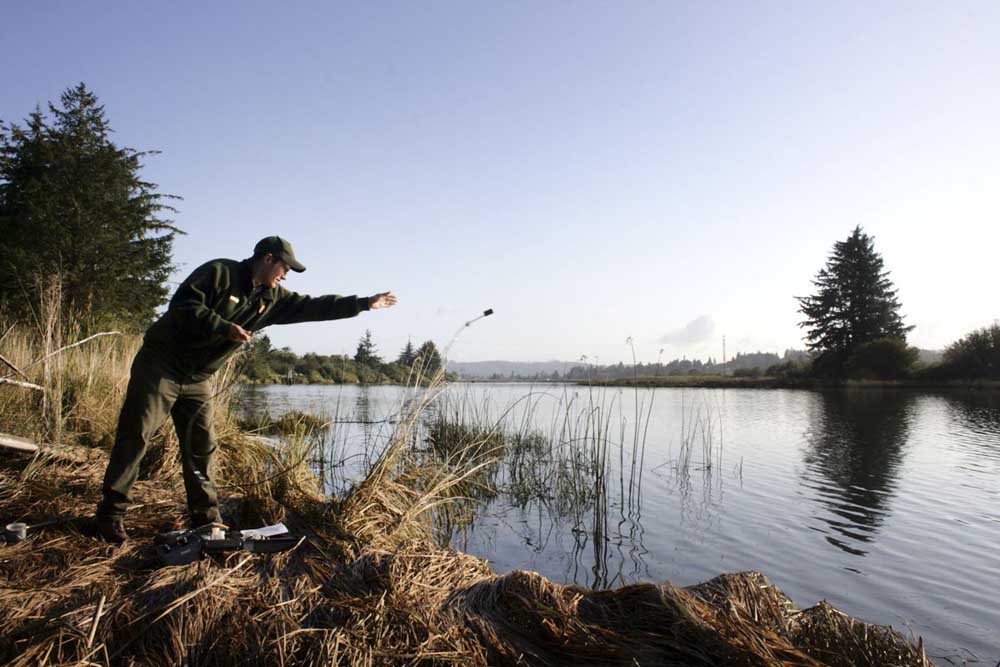Lewis and Clark park checks its pulse
Published 4:35 am Friday, March 27, 2015

- Jason Smith, a former National Parks Services biological technician (now with Columbia River Estuary Study Taskforce), tests water quality at Lewis and Clark National Historical Park.
Similar to a someone checking their cholesterol or blood pressure, Lewis and Clark National Historical Park regularly checks its own vital signs.
The national park is a member of the North Coast and Cascades Network, a group of seven national parks that work together to monitor 12 vital signs. Results are collected for the National Parks Service Inventory and Monitoring Program.
Lewis and Clark National Historical Park Superintendent Scott Tucker said his park monitors seven vital signs, which include elk, land birds, marine intertidal, landscape dynamics, forest vegetation, water quality and climate change.
Much of the monitoring is done in the spring and summertime.
The importance, Tucker said, is to collect baseline data to see what the environmental impacts are on the park, which is especially valuable for climate-change and water-quality trends.
A healthy national park often indicates a healthy ecosystem in the surrounding area, Tucker said.
“Our goal is to restore the landscape to the atmosphere the Corps of Discovery would have recognized, which is the natural ecosystem of the area,” Tucker said.
One of the more interesting, but least glamorous, monitoring is to see how the elk use the approximately 1,000 acres around Fort Clatsop National Memorial, LCNHP Chief of Resources Chris Clatterbuck said.
Earlier this month, the park finished its seventh year of elk monitoring. Unlike the larger national parks in the North Coast and Cascades Network that use helicopters, LCNHP staff and volunteers hike to 68 plots around the park to record the presence and amount of elk feces.
“We go and crawl through the forest to collect elk pellets,” Clatterbuck said.
Recording the pellets show where the elk are roaming. Data collected this year is still being processed. A four-year study completed last year showed the number of elk using the park land is possibly declining. The elk herds in the park are likely not the same as the ones often seen in Gearhart, officials say.
“There was a beginning of a trend, but it’s not statistically significant,” Clatterbuck said.
Two more years of data is expected to offer a more accurate trend line, according to the park.
The other national parks in the North Coast and Cascades Network — Olympic, North Cascades, Mount Rainier, San Juan Island, Fort Vancouver and Ebey’s Landing In Washington — regularly send scientists to assist Lewis and Clark park with monitoring its other vital signs.
Without the Network’s help, Tucker said, most of the monitoring would be impossible.
“It really leverages us,” Tucker said. “On a national park scale, we are brand new. To employ scientists year-round is impossible with our budget.”
Monitoring landscape dynamics is done primarily with Geographic Information Systems, or GIS, which is operated by the three large parks in the Network — Olympic, North Cascades and Mount Rainier.
For land-bird monitoring, trained scientists come to LCNHP and listen to the bird’s morning calls.
“It’s nice to be bundled with these larger parks for those shared resources,” LCNHP Natural Resource Program Manager Carla Cole said.
The North Coast and Cascades Network is one of 32 Networks of national parks across the country formed in 2001 for the NPS Inventory and Monitoring Program.
The Network was the first one to get funded, according to the Network’s I&M Program Manager Mark Huff.
“Stepping back and looking at the importance of national parks, these are our treasures that we are giving to the next generation. The important part the parks play here is we want to take the pulse on these vital systems,” Huff said. “That is one of the underpinnings of why Congress wanted to fund this, first for inventory and then long-term monitoring to maintain the health of the ecosystem.”
A recent success of the Network revolved around its marine intertidal monitoring.
Huff said marine scientists from Olympic National Park were the first to discover the sea star wasting disease that struck the West Coast last year. Sea star populations plummeted last year from the epidemic, which killed more than 90 percent during the 2014 beach season.
Through their monitoring, the Olympic National Park scientists were able to alert the problem to other sites along the coast, including LCNHP’s intertidal monitoring site at Ecola State Park in Cannon Beach.
“By having a program where you are intentionally putting people out in force, you can see it is paying dividends,” Huff said.
While trekking around the Fort Clatsop site to monitor vital signs, park staff believe they are carrying on Lewis and Clark’s tradition of scientific observations.
More than two centuries ago, Lewis and Clark camped at the site for a winter season and took inventory of the species, made detailed weather reports and collected other data, similar to the work park staff does year-round.
Tucker said other park superintendents wish they had someone come through their park 200 years ago and document everything they saw. The local park is lucky in that way, he said, especially also considering the oral history passed down by the Chinook and Clatsop tribes.
“We have a road map of what those natural ecosystems were,” Tucker said.
The park’s recent focus is on restoring its forest and wetlands after years of logging operations. Consistent monitoring is an important piece of the restoration effort, Tucker said.
“We can control what comes out of the park,” Tucker said. “And knowing our park, all of our vital signs are functioning.”




